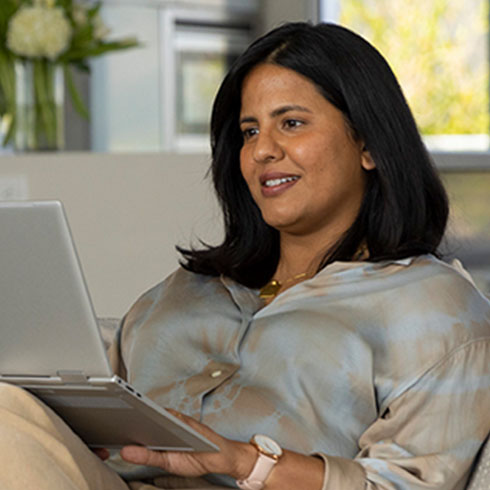Thanks, Mom, for all the great financial advice!
Several of our women leaders remember the valuable lessons their mothers taught them and share tips to help you teach your children about money
THINK ABOUT THE SATISFACTION you feel when you work hard, rise in your profession and have the means to support the causes you care about. Or the regret when you realize you’ve missed out on a potential investment opportunity.
Where do those emotions come from?
Your approach to money likely has its roots in childhood when your parents passed on valuable financial lessons. Every mom has her own methods for creating teachable financial moments, says Jennifer Chandler, head of Philanthropic Solutions at Bank of America Private Bank. “My mother had very little but always gave back to others. She stressed the value of working hard for the things you want and learned to be very creative with the little we had. If I wanted something, I knew I had to work for it.”
In the slideshow below, several women leaders at Bank of America share more of what their mothers taught them — plus some tips you may find helpful in passing on financial lessons to your own children. (Use the Financial Flash Card and Pop Quiz at the bottom of the page to get your kids thinking about key money concepts.)
My first memory of money was from a childhood book my mom would read called Pinchpenny Mouse —about a mouse who always came home from work and saved his money. When a tragedy hit the village and everybody needed money, they all came to him for help. It helped shape my view of money as an empowering tool and is one of the reasons I’m so attentive to preparing for a rainy day.


I’m very passionate about passing along to my children the core financial lessons I received from my parents. We regularly talk about how much things cost, budgeting, saving and setting aside an emergency fund. We believe that introducing them to these fundamental concepts will help provide a solid foundation for their future financial empowerment.
“My mom was always very careful when it came to spending,” recalls Villani. “It’s a tendency that has stayed with me throughout my life and a value I strive to instill in my own kids as they grow. We all want to give our kids more than we had growing up, but being smart about money and not being wasteful is a lesson I really focus on teaching my kids.”


Villani focuses on teaching her children about the importance of starting to budget for their activities and the impact that can have if they exceed their plan, e.g., something as simple as their lunch money account at school. “Don’t shield your kids from the costs they incur,” counsels Villani. “At their age, we pay for almost everything, but it’s important for them to start to understand the concept of money so that they are empowered with the knowledge they need to build strong money habits as they grow up.”
“The thing that she impressed upon me is that you can’t take anything for granted,” Auerbach-Rodriguez says of her mother, who emigrated from the Dominican Republic in her early teens, putting herself through college and always working to earn money. “She always said how important it is to earn and save your money. My mom constantly reminded me how much work went into every single dollar earned.”


Even though her son is just a toddler, Auerbach-Rodriguez is introducing financial awareness, using everyday experiences to express gratitude. “We’ll talk about never wasting or playing with our food, and I feel strongly that he understands our family’s history was not one of abundance,” she says.
Though Chandler’s mother came from very little, she always saw the silver lining. “She believed that you take what you have and do something creative with it,” Chandler recalls. There will always be people with more than you, so you appreciate what you have and give what you have left over. “Joy is in the act of giving, like when she made a prom dress for a friend who couldn’t afford one. She got a lot of pleasure from those moments.”


Chandler encourages her four kids, ages 11 to 17, to give back like their grandmother did. “Now that my kids have their own accounts with Bank of America, they can earn, save and give,” she notes. “And being able to regularly check their balances gives them a greater appreciation of saving and the power of compounding.” Chandler assigns chores and gives them their allowance with a simple transfer to their accounts. “We also teach them the importance of giving back both their time and treasure,” she notes. “They’re quick to volunteer and more than willing to “round up” at the register as a simple way to provide financial support.”
The most valuable money lesson Fahmy’s mother taught her was to invest in herself. For her, that meant pursuing an education. Her mother had paused her own career after having three children. “However,” says Fahmy, “it was very important to her that her daughters had the best education so they could stand on their own feet and achieve financial independence.”


Fahmy teaches her 12-year-old daughter to set goals – and develop patience. “A few years ago, Riley really wanted a dog,” Fahmy says, “but I told her that was a want, not a need, and she should save for it.” They created a “puppy goal” target amount. “She earns money by completing chores and puts away what she received for her birthday.” Fahmy also set up a SafeBalance Banking® for Family Banking account so her daughter can track her progress toward her goal.
When Dugan headed off to college, her mother cosigned her first credit card — an action that led to a lasting money lesson. “I maxed it out,” Dugan admits. Her mom bailed her out and then set up a repayment plan. “She sat me down and said, ‘I want you to feel what happens when you do something like this.’ I worked for an entire summer, and I was paying off things that I had purchased months earlier. I couldn’t even remember what they were.”


When Dugan sent her oldest son off to college last fall, she was determined not to let him make the same mistakes. “He already had the bank account we opened for him when he turned 14, but we also got him his first credit card and opened a Merrill Edge account for him,” she recalls. “When he came home for winter break, we were thrilled to see how well he managed his finances. All those conversations over the years really helped shape his focus on being financially responsible.”
How early can you start? Sooner than you think. Researchers have found that:
- By age 4 or 5, children start to understand the relationship between buying and owning things
- By age 5 or 6, they start to grasp the ideas of cost, prices, supply and demand1
Jennifer Auerbach-Rodriguez, head of Strategic Growth Markets and Client Development Executive at Merrill Wealth Management, began explaining the concepts of “have” and “have not” and “wants” and “needs” in very basic terms when her child was 2 years old.
As your children enter their teens, there are other more hands-on activities you can encourage them to try. In the video below, Savita Subramanian, head of U.S. Equity & Quantitative Strategy and head of ESG Research at BofA Global Research, shares how she started teaching her kids about the power of investing.
What about allowances — should you tie them to chores?
64% of parents who give their kids an allowance require them to earn it by doing chores.2
Nancy Fahmy, head of the Investment Solutions Group at Bank of America, started her daughter on an allowance tied to chores at age 10. It’s a good way to begin instilling the important value of working for the things you want. However, allowances don’t always need to be tied to chores or work. There’s no one-size-fits-all approach. What’s most important are the money management conversations you have around allowances and the lessons you impart to your children about spending, saving and giving.
The resources below can help you start conversations about money with your children. Use them to create your own teachable moments. (For more suggestions, check out this “Financial Education Handbook: Practical Ideas to Engage the Rising Generation,” from Merrill.)
Those conversations will change and become more complex as your children grow, and at some point, your financial advisor may be able to provide resources and guidance as well. But getting started early is key. “Motherhood is a journey and raising your children to be financially responsible is part of that,” notes Kristen Dugan, chief supervisory officer at Merrill Wealth Management. Thinking back on her own childhood, Auerbach-Rodriguez recalls, “Early experiences made me who I am.”
Explore these resources
What’s a ‘want’? What’s a ‘need’?
Moms, download this flash card and ask your kids, from toddlers to tweens, to identify the “wants” and the “needs.” Use this exercise to jump-start conversations about how knowing the difference can help you create realistic spending habits. Explain the importance of budgeting for your needs and saving up for the things you want.
Food
Puppy

Shoes
Toys
Housing

Bicycle


True or false: Your credit score is as important as your school grades

True or false: Saving and investing are the same thing

True or false: There’s more than one way to save for college
Choose your advisor in a more personalized way
All our advisors are committed to putting your needs and priorities first. Find some who match your personal preferences too.
Try Advisor Match
Want us to contact you?
Personalized Goals Review
Get insights and resources tailored to your unique priorities and goals.














